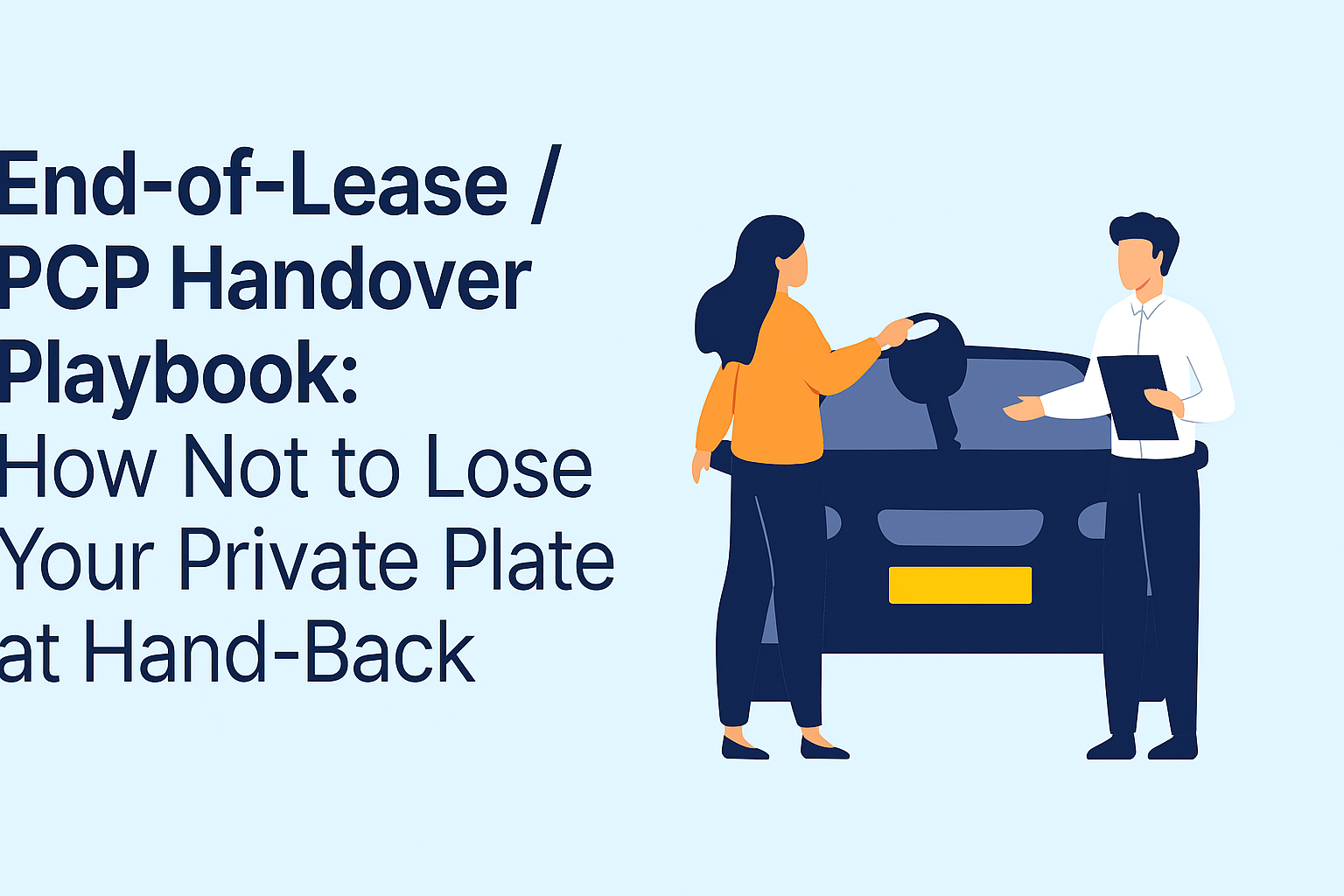
Private number plates are more than just a registration — they’re a personal asset, a branding tool, and often a significant financial investment. But when your vehicle lease or Personal Contract Purchase (PCP) agreement ends, failing to follow the correct steps could mean losing your plate permanently. This playbook outlines the essential timelines, retention procedures, and documentation you need to protect your private plate during hand-back.
Why Private Plates Get Lost at Handover
When a leased or PCP-financed vehicle is returned, ownership reverts to the finance company or dealership. If your private plate is still assigned to the vehicle at this point, it may be transferred with it — and recovering it later can be difficult or even impossible.
Common reasons plates are lost:
- The retention process wasn’t started early enough
- The plate was still assigned at the time of hand-back
- The finance company or dealer disposed of the vehicle before DVLA processing was complete
- There was no written agreement confirming plate retention
Timelines: When to Start the Plate Retention Process
Timing is critical. The DVLA plate retention or transfer process can take several days to weeks, depending on whether you’re retaining the plate or assigning it to another vehicle.
Recommended Timeline:
| Time Before Handover | Action |
| 6–8 weeks | Review lease/PCP agreement and contact finance company to confirm plate retention policy |
| 4–6 weeks | Begin DVLA retention or transfer process online |
| 2–4 weeks | Chase confirmation from DVLA and ensure new V5C is issued |
| 1 week | Confirm with dealer/finance company that the plate is no longer linked to the vehicle |
| Handover day | Ensure the vehicle has its original registration or a replacement plate fitted |
Step-by-Step: How to Retain Your Private Plate
1. Check Your Agreement
Review your lease or PCP contract. Some agreements restrict modifications, including plate changes. Contact the finance company to confirm you’re allowed to retain or transfer the plate before hand-back.
2. Use the DVLA Online Service
Visit the DVLA’s personalised registration portal to:
- Retain the plate (for future use)
- Transfer the plate to another vehicle
You’ll need:
- The vehicle’s V5C (logbook)
- A debit/credit card for the £80 DVLA fee
- The registered keeper’s details (usually the finance company)
If the finance company is the registered keeper, they must initiate or approve the retention.
3. Get Written Permission
Request written confirmation from the finance company or dealer that:
- They approve the plate retention or transfer
- They will not dispose of the vehicle until the DVLA process is complete
- They will provide the updated V5C once the plate is removed
This protects you if there’s a dispute or delay.
4. Wait for DVLA Confirmation
Once processed, DVLA will issue:
- A retention certificate (V778) if you’re keeping the plate
- A new V5C showing the vehicle’s original registration
Do not hand back the vehicle until you receive these documents.
5. Fit the Replacement Plates
Before returning the vehicle, ensure it displays its original registration plates. You can order these from a registered supplier using the new V5C.
What to Get in Writing: Your Safety Net
To avoid misunderstandings, always request written confirmation of the following:
- Approval from the finance company to retain or transfer the plate
- Confirmation that the vehicle will not be handed back or sold until the DVLA process is complete
- Agreement that they will provide the updated V5C once the plate is removed
- A copy of the retention certificate (V778) or new V5C for your records
This documentation is vital if the plate is lost or misassigned — it proves your intent and protects your rights.
Transferring to a New Vehicle
If you’re planning to assign the plate to a new car, you can do this immediately after retention using the DVLA’s online service. You’ll need:
- The V778 retention certificate
- The new vehicle’s V5C
- A £0 fee if done within the retention period
Make sure the new vehicle meets DVLA requirements (e.g., it must be taxed and have an MOT if over 3 years old).
What Happens If You Miss the Deadline?
If the vehicle is returned with the private plate still assigned:
- The plate may be lost permanently
- You may need to buy it back from the finance company or dealer (if they still have it)
- DVLA may refuse to reissue the plate if it’s been reassigned
In some cases, the plate may be auctioned or reallocated, especially if the vehicle is sold or scrapped.
Pro Tips to Avoid Losing Your Plate
- Start early: Begin the retention process at least 4–6 weeks before hand-back
- Keep records: Save all emails, confirmations, and DVLA documents
- Don’t rely on verbal promises: Always get written approval
- Use tracked delivery: If sending documents by post, use recorded delivery
- Double-check the V5C: Ensure the plate is removed before returning the vehicle
For more expert guidance, see our article on how to transfer a private plate and our guide to plate retention certificates.
Final Checklist Before Handover
✅ Plate retention or transfer completed via DVLA ✅ Retention certificate (V778) or new V5C received ✅ Replacement plates fitted to the vehicle ✅ Written confirmation from finance company/dealer ✅ All documents saved and backed up
Your private plate is a valuable asset — don’t let it slip away at the end of your lease or PCP agreement. By following this playbook, starting early, and securing the right documentation, you can ensure a smooth handover and keep your plate safe for future use.
For more insights and expert advice on personalised registrations, visit Regplates.com — your trusted partner in plate protection.

Jon Cherry is a Director of leading personalised number plate dealer Regplates.com. Jon has over 25 years industry experience handling some of the most expensive plates ever sold with many high profile and celebrity clients. Active since 1991 in the number plate industry, Jon is currently Chairman of the Cherished Numbers Guild, a trade body representing number plate dealers in the UK. Jon has written many articles on the industry and insight into the future of numberplates and the market as a whole.




